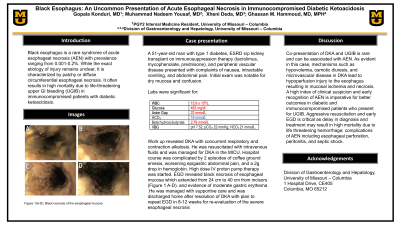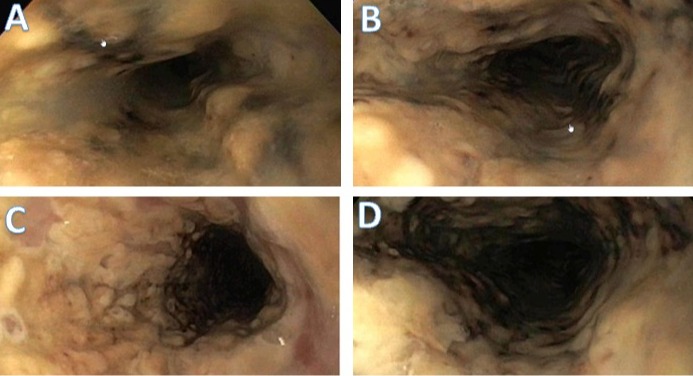Monday Poster Session
Category: Esophagus
P1891 - Black Esophagus: An Uncommon Presentation of Acute Esophageal Necrosis in Immunocompromised Diabetic Ketoacidosis
Monday, October 23, 2023
10:30 AM - 4:15 PM PT
Location: Exhibit Hall

Has Audio

Gopala Konduri, MD
University of Missouri-Columbia
Columbia, MO
Presenting Author(s)
Gopala Konduri, MD, Muhammad Nadeem. Yousaf, MD, Xheni Deda, MD, Ghassan M. Hammoud, MD
University of Missouri-Columbia, Columbia, MO
Introduction: Black esophagus, also known as acute esophageal necrosis (AEN), is a rare clinical syndrome characterized by patchy or diffuse circumferential esophageal necrosis. It may result in high mortality due to life-threatening upper gastrointestinal bleeding (UGIB) in immunocompromised patients with diabetic ketoacidosis. The reported incidence of AEN ranges between 0.01% to 0.2%, and presents most often in patients with multiple comorbidities.
Case Description/Methods: A 51-year-old man with type 1 diabetes, end stage renal disease status post kidney transplant on immunosuppression therapy (tacrolimus, mycophenolate, prednisone), and peripheral vascular disease presented with complaints of nausea, intractable vomiting, and abdominal pain. Initial Exam was notable for dry mucosa, and confusion. Labs were significant for a leukocytosis of 15.9 x 109/L, elevated glucose (463 mg/dL), anion gap (22 mmol/L) with low HCO3 (18 mmol/L), and beta hydroxybutyrate (2.79 mmol/L). Venous blood gas showed 7.52 pH, pCO2 of 22 mmHg, and HCO3 of 21 mmol/L. His work up was consistent with diabetic ketoacidosis (DKA) with concurrent respiratory and contraction alkalosis. He was resuscitated with intravenous fluids, and was managed for DKA in the medical intensive care unit. His hospital course was complicated with 2 episodes of coffee ground emesis and worsening epigastric abdominal pain and a 2g drop in hemoglobin. He was started on high dose IV proton pump therapy. Esophagogastroduodenoscopy (EGD) revealed black necrosis of esophageal mucosa which extended from 24 cm to 40 cm from incisors (Figure) and evidence of moderate gastric erythema. He was managed with supportive care and was discharged home with plan to repeat EGD in 8-12 weeks for re-evaluation of the severe esophageal necrosis.
Discussion: Co-presentation of DKA and UGIB is rare and can be associated with AEN. Mechanisms including hypovolemia, osmotic diuresis, and microvascular disease in DKA lead to hypoperfusion injury to the esophagus resulting in mucosal ischemia and necrosis. A high index of clinical suspicion and early recognition of AEN is imperative for better outcomes in diabetic and immunocompromised patients who present for UGIB. Aggressive resuscitation and early EGD is critical as delay in diagnosis and treatment may result in high mortality due to life threatening hemorrhage, in addition to other complications of AEN including esophageal perforation, peritonitis, and septic shock.

Disclosures:
Gopala Konduri, MD, Muhammad Nadeem. Yousaf, MD, Xheni Deda, MD, Ghassan M. Hammoud, MD. P1891 - Black Esophagus: An Uncommon Presentation of Acute Esophageal Necrosis in Immunocompromised Diabetic Ketoacidosis, ACG 2023 Annual Scientific Meeting Abstracts. Vancouver, BC, Canada: American College of Gastroenterology.
University of Missouri-Columbia, Columbia, MO
Introduction: Black esophagus, also known as acute esophageal necrosis (AEN), is a rare clinical syndrome characterized by patchy or diffuse circumferential esophageal necrosis. It may result in high mortality due to life-threatening upper gastrointestinal bleeding (UGIB) in immunocompromised patients with diabetic ketoacidosis. The reported incidence of AEN ranges between 0.01% to 0.2%, and presents most often in patients with multiple comorbidities.
Case Description/Methods: A 51-year-old man with type 1 diabetes, end stage renal disease status post kidney transplant on immunosuppression therapy (tacrolimus, mycophenolate, prednisone), and peripheral vascular disease presented with complaints of nausea, intractable vomiting, and abdominal pain. Initial Exam was notable for dry mucosa, and confusion. Labs were significant for a leukocytosis of 15.9 x 109/L, elevated glucose (463 mg/dL), anion gap (22 mmol/L) with low HCO3 (18 mmol/L), and beta hydroxybutyrate (2.79 mmol/L). Venous blood gas showed 7.52 pH, pCO2 of 22 mmHg, and HCO3 of 21 mmol/L. His work up was consistent with diabetic ketoacidosis (DKA) with concurrent respiratory and contraction alkalosis. He was resuscitated with intravenous fluids, and was managed for DKA in the medical intensive care unit. His hospital course was complicated with 2 episodes of coffee ground emesis and worsening epigastric abdominal pain and a 2g drop in hemoglobin. He was started on high dose IV proton pump therapy. Esophagogastroduodenoscopy (EGD) revealed black necrosis of esophageal mucosa which extended from 24 cm to 40 cm from incisors (Figure) and evidence of moderate gastric erythema. He was managed with supportive care and was discharged home with plan to repeat EGD in 8-12 weeks for re-evaluation of the severe esophageal necrosis.
Discussion: Co-presentation of DKA and UGIB is rare and can be associated with AEN. Mechanisms including hypovolemia, osmotic diuresis, and microvascular disease in DKA lead to hypoperfusion injury to the esophagus resulting in mucosal ischemia and necrosis. A high index of clinical suspicion and early recognition of AEN is imperative for better outcomes in diabetic and immunocompromised patients who present for UGIB. Aggressive resuscitation and early EGD is critical as delay in diagnosis and treatment may result in high mortality due to life threatening hemorrhage, in addition to other complications of AEN including esophageal perforation, peritonitis, and septic shock.

Figure: Scattered necrotic mucosa throughout the esophagus (A,B,C,D).
Disclosures:
Gopala Konduri indicated no relevant financial relationships.
Muhammad Yousaf indicated no relevant financial relationships.
Xheni Deda indicated no relevant financial relationships.
Ghassan Hammoud indicated no relevant financial relationships.
Gopala Konduri, MD, Muhammad Nadeem. Yousaf, MD, Xheni Deda, MD, Ghassan M. Hammoud, MD. P1891 - Black Esophagus: An Uncommon Presentation of Acute Esophageal Necrosis in Immunocompromised Diabetic Ketoacidosis, ACG 2023 Annual Scientific Meeting Abstracts. Vancouver, BC, Canada: American College of Gastroenterology.
